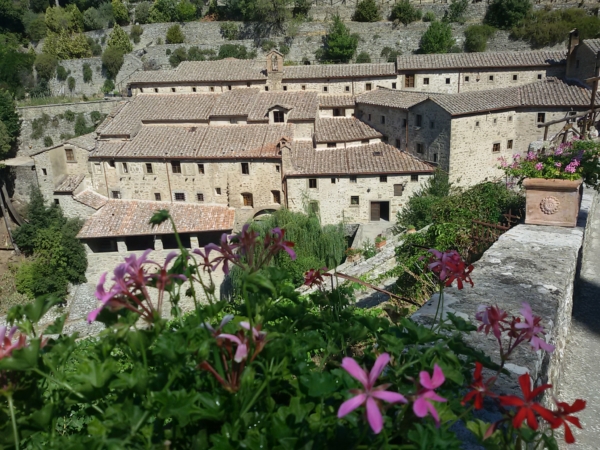Cortona Etruscan heart
Page index
Cortona Etruscan heart
Cortona is an Etruscan town in Valdichiana of about 22,000 people, and its history is older than Rome.
It is a very traditional Tuscan village, very charming for the medieval stone architecture, unique and worth seeing.
Cortona is in a great location for day trips.
You can reach Assisi, Siena, or Arezzo in an hour. It only takes 45 minutes to get to Perugia and 30 minutes to reach Montepulciano and Val d’Orcia.
Cortona is an ideal destination for day trips or as a starting point for various tours.
Check out the main attractions of Cortona in this article.
History
Ancient history
Cortona was founded by the Etruscans in ancient times. The Etruscans were a significant population in Tuscany and northern Lazio. Cortona was one of their main cities, called a “lucumònia”, from the 8th to 7th centuries B.C.
The city’s strategic hilly location gave it an advantage for defense and control over the surrounding areas. You can still see parts of the ancient wall from the 4th century BC today.
In the end, like many other Etruscan cities, Cortona became subject to Roman rule by the end of the 4th century BC. Later on, in 450 AD, the Goths occupied the city after the fall of the Western Roman Empire.
Medieval and modern history
The Etruscans founded Cortona ages ago.
They were an important group in Tuscany and northern Lazio. Cortona was one of their main cities, and it was called a “lucumònia” from the 8th to 7th centuries B.C.
Cortona’s hilltop location was great for defense and control of the surrounding areas. You can still see parts of the ancient wall from the 4th century BC today.
Like many other Etruscan cities, Cortona fell under Roman rule in the end of the 4th century BC. Later on, the Goths took over the city in 450 AD after the fall of the Western Roman Empire.
What to see in town
Piazza della Repubblica
The cornerstone of the city, today as in the past, is undoubtedly Piazza della Repubblica. It serves as a hub where all aspects of the city converge, as if drawn together by some invisible force.
As you enter the square, you will be greeted by the bustling tables of cafes, the charming shops of artisans, and the grand arcades of noble palaces. Today, just as it did in ancient times, Piazza della Repubblica serves as the heart of Cortona.
It’s here where the two most important streets of the city, the Cardo and the Decumano, intersected at the time of the Romans. A prominent feature of the square is the majestic Palazzo Comunale, which dates back to the 12th century, and has served as the seat of public administration ever since. Inside, visitors can admire the Sala del Consiglio, the city council hall, with its beautifully crafted wooden benches, medieval frescoes, and a stone fireplace.
Ruga piana
Via Nazionale, the main street in town, is still often referred to with its ancient name, Ruga Piana
It crosses it from west to east, up to Piazza Garibaldi and beyond, towards the Parterre, and it is practically the only flat road in the entire town
This is where the main shops are located and it is here that the locals love to stroll on holidays.
Various side streets also start from here, offering the most curious visitor some truly unique views of medieval architecture.
The Cathedral
It was originally built on the ruins of an ancient pagan temple, and around the 11th century became a town parish.
Santa Maria Assunta, this is the name of the church, became a cathedral only in 1507 at the behest of the pope.
The interior, thanks to changes in the 14th and 16th centuries, took on a more Renaissance character with references to Brunelleschi.
It consists of three naves divided by elegant columns and a beautiful barrel vault.
The works found there are a collection that spans the centuries up to the first half of the 1900s.
The church overlooks a small square that rests directly on the city walls, from which you can admire a splendid view of the valley.
Diocesan Museum
Right in front of the Cathedral, there is the beautiful Diocesan museum. It collects some of the most important works from the churches in the area.
Here you can admire works by Pietro Lorenzetti, a Sienese painter of the fourth century, who worked in Cortona. There are also several works by Luca Signorelli from Cortona, a precursor of mannerism. It is an artist who anticipated Michelangelo Buonarroti’s interest in anatomy.
But undoubtedly the masterpiece that makes this small museum so important is the marvelous Annunciazione by Beato Angelico, complete with predella, dated around 1430.
MAEC: the etruscan heart of Cortona
Palazzo Casali, behind the town hall, has housed the Etruscan Academy of Cortona since its foundation in 1727.
This prestigious cultural club was created with the aim of pursuing archaeological and historical studies and carry on the discussion of antiques culture, especially in relation to this territory.
This goal is achieved by collecting and cataloging items and creating opportunities to share the results through many public initiatives.
Perfectly in line with Enlightenment thought, the studies of the members of this institution are multiple and embrace all knowledge in an encyclopedic form.
In the past, illustrious members of the Academy were Charles Montesquieu, Voltaire, Johann J. Winckelmann, Antonio Muratori, Scipione Maffei and many others.
This is where the MAEC (Museum of the Etruscan Academy and of the city of Cortona) was born in 2005.
It is an unmissable collection for lovers of Etruscan culture, which collects artifacts found in the vicinity of Cortona or from private collections. The main pieces of the collection are the precious Etruscan chandelier, the Tabula Cortonensis, one of the most complete texts in the Etruscan language ever found.
This is why Cortona is said to have an Etruscan heart.
To the Egyptian section with valuable artifacts are added other extraordinary works that cross the history of Cortona over the centuries up to the present day.
Franciscan hermitage of “Le Celle”

Cortona Etruscan heart
private day trip from Florence
Few places in the world evoke the sense of peace and harmony with nature quite like the Franciscan Hermitage of “Le Celle”. This was the first convent founded by St. Francis of Assisi, around the year 1211, and it was here where he lived briefly before his death. Nestled in a corner of a hill surrounded by an enchanting forest, this place exemplifies how the hand of man can seamlessly blend into nature.
As you approach the entrance, a handwritten sign will greet you, inviting you to embrace the silence and tranquility of the monastery. Once inside, you will be greeted by the gardens of the monks, and then a small bridge that crosses a spectacular rocky waterfall.
Deep in the heart of the monastery lies an austere cell carved into the rock, which was all that St. Francis needed to live during his isolation. A truly unique place of silence and beauty.
Basilica of Santa Margherita
Santa Margherita da Cortona was an extraordinary figure of the Cortonese Middle Ages.
She was a devout and charitable Franciscan nun who lived in the 1200s, also founder of a hospital and a congregation to assist the needy. She lived in a tiny house near today’s church, totally dedicated to good works. For this, Pope Benedict XIII ordained her a saint in 1728.
To her memory is dedicated the homonymous Basilica just outside the city. Her body, intact after several centuries, is displayed in an urn on the high altar.
The basilica is appreciated for its neo-Gothic architecture and its lively paintings, as well as for the secluded position and the panoramic view overlooking the Valdichiana.
Church of Santa Maria delle Grazie al Calcinaio
Centuries ago, just outside the city walls, the Guild of Shoemakers used quicklime tubs for the tanning of leather, one of which had a depiction of a Virgin Mary with Child.
On Easter Day 1487 that particular image suddenly began to work miracles.
This event aroused such admiration that devotees and pilgrims from all places flocked to venerate the image. Thus, the Guild of Shoemakers, owner of the place, wanted to erect a church to welcome visitors.
The project was entrusted to Francesco di Giorgio di Martino, one of the greatest Sienese architect and painter of the Renaissance.
Lovers of Renaissance architecture consider this church a very high example of synthesis and management of forms and space.
Cortona in the popular culture: Under The Tuscan Sun
In 1994, Cortona gained international recognition with the publication of “Under the Tuscan Sun” by Francis Mayes.
This book became a bestseller and was later adapted into a film in 2003, starring Diane Lane.
The story follows the protagonist as she moves from New York to Cortona, trying to escape from a heartbreak and start a new life at Villa Bramasole, a cottage given to her by a friend.
The villa, along with the famous madonnina seen in the film, is located near the historic center of Cortona.
Food, wine and olive oil
The Cortona area is particularly suitable for olive cultivation, for the olive oil production.
However, no less important is the production of wine, which here finds its maximum expression with the syrah vines.
Already in the early 1900s, the companies planted this vine from the Rhone valley and today it represents about 80% of the area under vines.
There are many producers that offer visitors the opportunity to see their cellars and taste their products, both in town and in the countryside around town.
How to book your private excursion to Cortona Etruscan heart?
Click here
In Cortona, you will discover an authentic and ancient Tuscany.
You can choose to visit it together with other areas, such as Arezzo, Montepulciano, Assisi or spend the whole day here.
Click on the button below to discover our classic tour proposal, or to ask for a customized experience.
Get ready to discover the Etruscan heart of Cortona with our private excursion from Florence!






 tuscanyexcursions.com
tuscanyexcursions.com

